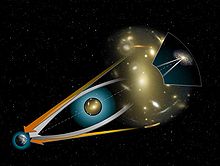Cosmic microwave background polarization

B-mode polarization is a polarization signal in the cosmic microwave background radiation. The pattern of polarization in the cosmic microwave background can be broken into two components. One, a curl-free, gradient-only component, the E-mode (named in analogy to electrostatic fields), was first seen in 2002 by the Degree Angular Scale Interferometer (DASI). The second component is divergence-free, curl only, and is known as the B-mode[1] (named in analogy to magnetic fields).
Cosmologists predict two types of B-modes, the first generated during cosmic inflation shortly after the big bang,[2][3][4] and the second generated by gravitational lensing at later times.[5]
BICEP2 announced in March 2014 that they had detected the first type of B-modes, consistent with inflation and gravitational waves in the early universe at the level of r = 0.20+0.07
−0.05, which is the amount of power present in gravitational waves compared to the amount of power present in other scalar density perturbations in the very early universe.[6][7][8]
The second type of B-modes was discovered earlier using National Science Foundation's South Pole Telescope with help from the Herschel Space Observatory.[9] This discovery may help test theories on the origin of the universe. Scientists are using data from the Planck mission by the European Space Agency, to gain a better understanding of these waves.[10][11][12]
Paul Steinhardt is skeptical, suggesting that light scattering from cosmic dust and synchrotron radiation from electrons, both in the Milky Way Galaxy, could have caused the readings. [13]
References
- ^ Cosmic Microwave Background Polarization: The Next Key Toward the Origin of the Universe, 2003, Yuki D. Takahashi
- ^ Seljak, U. (June 1997). "Measuring Polarization in the Cosmic Microwave Background". Astrophysical Journal. 482: 6. arXiv:astro-ph/9608131. Bibcode:1997ApJ...482....6S. doi:10.1086/304123.
- ^ Seljak, U.; Zaldarriaga M. (March 17, 1997). "Signature of Gravity Waves in the Polarization of the Microwave Background". Phys. Rev.Lett. 78 (11). arXiv:astro-ph/9609169. Bibcode:1997PhRvL..78.2054S. doi:10.1103/PhysRevLett.78.2054.
- ^ Kamionkowski, M. (March 17, 1997). "A Probe of Primordial Gravity Waves and Vorticity". Phys. Rev.Lett. 78 (11). arXiv:astro-ph/9609132. Bibcode:1997PhRvL..78.2058K. doi:10.1103/PhysRevLett.78.2058.
{{cite journal}}: Unknown parameter|coauthors=ignored (|author=suggested) (help) - ^ Zaldarriaga, M.; Seljak U. (July 15, 1998). "Gravitational lensing effect on cosmic microwave background polarization". Physical Review D. 2. 58. arXiv:astro-ph/9803150. Bibcode:1998PhRvD..58b3003Z. doi:10.1103/PhysRevD.58.023003.
- ^ "Gravitational waves: have US scientists heard echoes of the big bang?". The Guardian. 2014-03-14. Retrieved 2014-03-14.
- ^ http://www.nytimes.com/2014/03/18/science/space/detection-of-waves-in-space-buttresses-landmark-theory-of-big-bang.html?_r=0
- ^ [1], 'BICEP2 I: Detection Of B-mode Polarization at Degree Angular Scales' on arXiv
- ^ http://www.nature.com/news/polarization-detected-in-big-bang-s-echo-1.13441
- ^ ESA Planck (Oct 22, 2013). "Planck Space Mission". Retrieved Oct 23, 2013.
- ^ NASA/Jet Propulsion Laboratory (October 22, 2013). "Long-sought pattern of ancient light detected". ScienceDaily. Retrieved October 23, 2013.
- ^ Hanson, D.; et al. (Sep 30, 2013). "Detection of B-Mode Polarization in the Cosmic Microwave Background with Data from the South Pole Telescope". Physical Review Letters. 14. 111. arXiv:1307.5830. Bibcode:2013PhRvL.111n1301H. doi:10.1103/PhysRevLett.111.141301.
{{cite journal}}: Explicit use of et al. in:|author2=(help) - ^ Big Bang research blunder leaves multiverse theory in ruins, theoretical physicist claims
